How many people do we grant asylum or protection to?
Updated 24 September 2020
Back to ‘Immigration statistics, year ending June 2020’ content page.
This is not the latest release. View latest release.
Data relate to the year ending June 2020, and all comparisons are with the year ending June 2019, unless indicated otherwise.
Some data relate to the second quarter of 2020 – 01 April to 30 June 2020. All comparisons are with the same period in 2019, unless indicated otherwise.
On 11 March 2020, the World Health Organisation (WHO) declared the COVID-19 outbreak as a global pandemic. A range of restrictions relating to the outbreak began on 12 March 2020, the Foreign and Commonwealth Office (FCO) advised against all non-essential overseas travel on 17 March 2020, and advised all British travellers to return to the UK on 23 March 2020, the same day as the UK lockdown measures were announced.
Restrictions were put in place across Europe and other parts of the world in the run up to the UK outbreak, which will also have impacted travel to the UK prior to these dates. The COVID-19 pandemic has had a significant impact on the UK immigration system, both in terms of restricting migrant movements to and from the UK and the impact on operational capacity.
Year ending comparisons that follow will reflect the restrictions in place during this period of the pandemic.
This section contains data on:
- Asylum applications and initial decisions, including unaccompanied asylum-seeking children (UASC)
- Resettlement
- Family reunion visas granted
- Asylum support
- Outcome analysis of asylum applications
- Dublin regulation
1. People granted protection and other leave through asylum and resettlement routes
The UK offered protection – in the form of asylum, humanitarian protection, alternative forms of leave and resettlement – to 16,952 people in the year ending June 2020, 8% lower than the previous year, although higher than levels seen prior to 2019.
The number of grants of protection and alternative forms of leave in the year ending June 2020 included:
- 11,116 grants of asylum, up 5% compared with the previous year, with notable increases in grants to Iranian (up 16% to 2,319), Sudanese (up 17% to 1,391), Eritrean (up 1% to 1,399), and Syrian (up 28% to 782) nationals
- 1,387 grants of humanitarian protection, up 24% – over half of these (59%) were granted to Libyan nationals
- 889 grants of alternative forms of leave following an application for asylum, down 23%
- 3,560 grants of protection through resettlement schemes, 37% fewer than in the previous year, largely due to the impact of the COVID-19 pandemic. Three-quarters of resettlement cases were Syrian nationals
In addition to those granted asylum, humanitarian protection and alternative forms of leave at initial decision following an asylum application, a further 2,932 had an appeal allowed following an initial refusal of asylum.
Additionally, 6,320 Family reunion visas were issued to partners and children of those previously granted asylum or humanitarian protection in the UK, 7% more than the previous year.
The increase in people granted protection since 2018 is primarily due to an increase in the initial grant rate for asylum applications – which rose from 35% in 2018 to 53% in year ending June 2020. The number of initial decisions in 2019 was higher than in 2018, but lower than 2015-17. The fall in people granted in the latest year is due to fewer initial decisions being made following the COVID-19 pandemic.
Figure 1: Grants1 of asylum, alternative forms of leave2, and resettlement3 in the UK, years ending June 2010 to June 20204
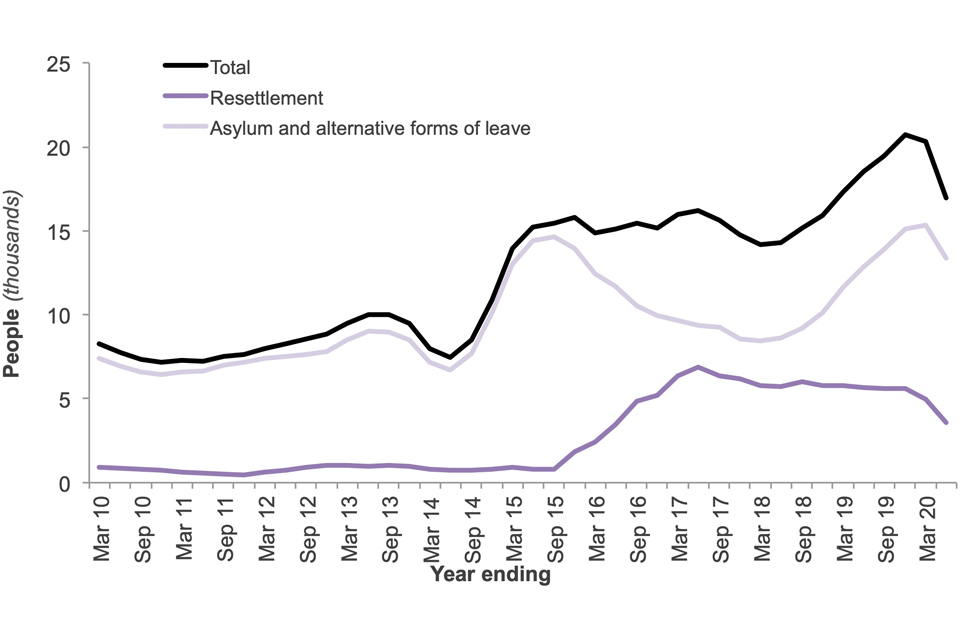
Source: Asylum applications, initial decisions and resettlement – Asy_D02)
Notes:
- Grants at initial decision. Actual number of grants at final decision (following appeal) will be higher.
- ‘Alternative forms of leave’ include grants of humanitarian protection, discretionary leave, grants under family and private life rules, leave outside the rules and UASC leave, that resulted from an asylum application.
- Resettlement data prior to 2013 are only available annually. Data for individual quarters in this period have been estimated by taking 25% of the annual total.
- Includes main applicants and dependants.
1.1 Resettlement
It was not possible to undertake resettlement activity during the second quarter of 2020 due to the impact of the coronavirus (COVID-19) pandemic.
The Vulnerable Person Resettlement Scheme (VPRS) accounted for over three-quarters (2,956) of those resettled in the UK in year ending June 2020. Since the government announced the expansion of the scheme on 7th September 2015, including the target of resettling an additional 20,000 refugees under the scheme by 2020, 19,768 refugees have been resettled in the UK. In addition, 239 refugees were resettled prior to this, and do not count towards the 20,000 target.
A further 201 people were resettled under the Vulnerable Children Resettlement Scheme (VCRS) in year ending June 2020, bringing the total to 1,826 since the scheme began in 2016.
Of those resettled under the VPRS and VCRS in the year ending June 2020, 104 refugees were resettled in the UK through the Community Sponsorship scheme, however due to the impacts of COVID-19, none of these were resettled in the latest quarter. Since the scheme began in July 2016, 449 refugees have been resettled by community sponsor groups.
Details of the schemes can be found in the ‘About the statistics’ section.
From 2020, once the 20,000 VPRS refugees have been resettled, the UK has announced plans to resettle around 5,000 of the world’s most vulnerable refugees in the first year of operation of a new resettlement scheme. The new resettlement scheme will consolidate the Vulnerable Persons Resettlement Scheme, the Vulnerable Children’s Resettlement Scheme and the Gateway Protection Programme into one global scheme.
2. Asylum applications
There were 32,423 asylum applications (main applicants only) in the UK in the year ending June 2020, similar to the previous year, and lower than the recent peak in year ending June 2016 (36,546), although that figure will have been impacted by the measures taken in response to COVID-19 in the latest quarter.
Figure 2: Asylum applications lodged in the UK, years ending March 2011 to March 20201

Source: Asylum applications, initial decisions and resettlement – Asy_D01)
Notes:
- Includes main applicants only.
Iran was the top nationality claiming asylum in the UK in year ending June 2020 (4,627 applications, up 10% compared with the previous year), followed by Albania (3,134, up 11%). About two thirds (66%) of applications from Iranian nationals were granted at initial decision, compared to around a third (32%) of those from Albanians – although additional numbers may be granted following appeal (see section 3 below).
The UK has seen an increase in Iranian nationals applying for asylum since the year ending June 2018 (2,432), corresponding with the growth in arrivals on small boats in the English Channel, but the latest numbers for Iranians are below the peak in year ending June 2016 (4,905). Prior to the increase from early 2018, applications from Albanian nationals had been relatively stable (since the year ending March 2014).
Figure 3: Top 10 nationalities1 claiming asylum2 in the UK and grant rate3,4 at initial decision (%), year ending June 2019 and year ending June 2020

Source: Asylum applications, initial decisions and resettlement – Asy_D01 and Asy_D02)
Notes:
- Top 10 nationalities in the most recent year.
- Includes main applicants only.
- The percentages in the chart are the grant rate at initial decision for each nationality in the most recent year.
- Grant rate is the proportion of initial decisions which resulted in a grant of protection or other leave. Grant rate is based on year of initial decision and is not directly comparable to applications, which are based on the date the asylum application was made.
The demographics of those applying for asylum varies by nationality. Around three-quarters (75%) of all asylum applicants in the latest year were male. However, of the top 10 nationalities applying, Afghan, Sudanese, and Iran nationals all saw a higher percentage of applications from males (90%, 89% and 85% respectively), whereas Vietnamese nationals had a below average proportion of applications from males (65%).
The largest numbers of asylum applications from Unaccompanied Asylum Seeking Children (UASC) in the year ending June 2020 came from Iranian (456), Vietnamese (420) and Afghan (409) nationals, who together accounted for 45% of the 2,868 UASCs in the latest year. UASCs accounted for 31% of all Vietnamese asylum applications over the period, 24% of all Sudanese asylum applications, while for Iranians only 10% of applications were from UASCs – similar to the average of 11% across all nationalities.
Of the 32,423 asylum applications, 44% of main applicants were aged 18 to 29, and a further 10% were children, meaning that around 46% were aged 30 years or over. The age of asylum applicants varied by nationality. For example, 33% of Afghan and Vietnamese main applicants were children (under the age of 18), which will in part reflect the high numbers of UASCs from these two nationalities, compared to 2% of Pakistani main applicants.
Figure 4: People applying for asylum in the year ending June 20201 by age group2 and sex
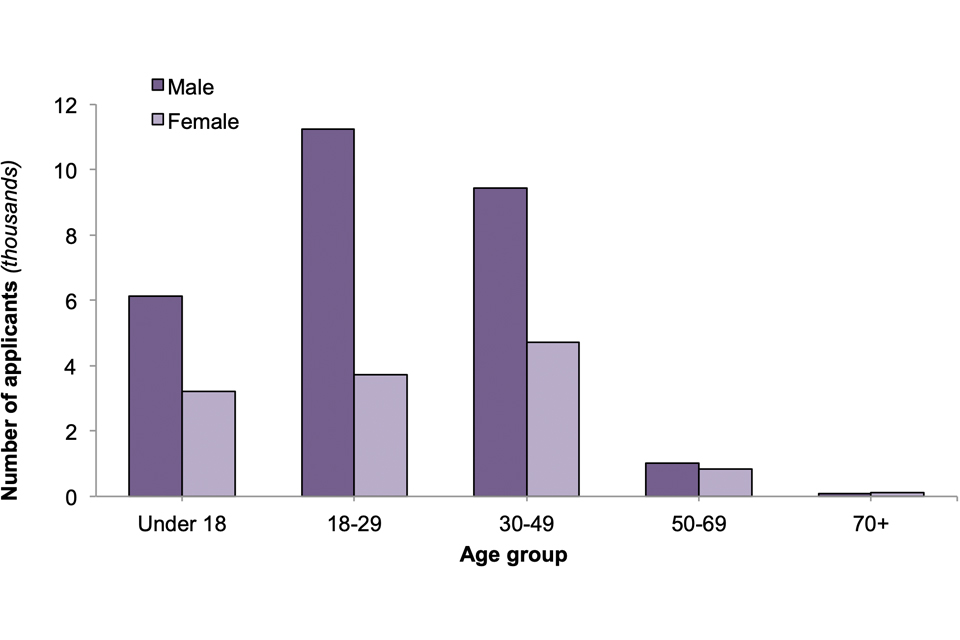
Source: Asylum tables – Asylum applications)
Notes:
- Includes main applicants and dependants.
- Age relates to age at time of application.
Eurostat Asylum statistics show the total number of asylum applications across the EU member states increased by 7% in year ending March 2020 (the latest period available for comparable statistics) compared with the previous year, although there were falls in applications to Italy, Netherlands and Germany. Some countries such as Belgium (up 9%), Greece (up 16%) and Spain (up 80%), all saw increases, whereas in France, applications were at a similar level to the previous year. The number of applications in the UK would be equivalent to the 5th largest of the EU member states in year ending March 2020; however, this would represent only the 16th largest when measured per head of the population.
2.1 Grant rate
In year ending June 2020, 53% of applications, at initial decision, resulted in grants of asylum, humanitarian protection or alternative forms of leave (such as discretionary leave or UASC leave), up from 44% in the previous year.
Data from the Home Office ‘cohort’ analysis, published annually in Asy_D04, show that the final grant rate typically increases by 10 to 20 percentage points following appeal. More detailed analysis can be found below in section 3 relating to the outcome of asylum applications.
Grant rates vary considerably by nationality as the protection requirements of specific nationalities or individuals vary. Of those nationalities that commonly claim asylum in the UK, Libyans (98%) and Syrians (96%) typically have high grant rates at initial decision, while nationals of India (3%), China (19%) and Bangladesh (16%) typically have low grant rates.
Only six nationalities, in the top ten, had a grant rate at initial decision of more than 50%, that is applicants were more likely than not to be granted protection. These six nationalities – Iran, Afghanistan, Eritrea, Vietnam, Sudan and Syria - together accounted for more than one third (36%) of asylum applications.
3. Outcome of asylum applications
The chart below gives an illustration of the outcomes of asylum applications made in the years 2016 to 2018, where the outcome is known. After the conclusion of any appeals, around half (54%) of all asylum applications in the UK resulted in some form of grant of leave to remain in the UK.
Of those applications received between 2016 and 2018, 36% were granted at initial decision. The proportion of initial decisions (excluding those that were granted asylum), which were subsequently appealed was 70%. The majority of these relate to refusals, although a small number of other decisions may also result in an appeal. After further consideration by HM Courts and Tribunals Service (HMCTS), 43% of appeals were allowed and 57% were rejected. Therefore, the grant rate for all applications for asylum made in 2016 to 2018 increased from 36% at initial decision, to 54% following appeal.
Figure 5: Outcomes of asylum applications with known outcomes, 2016 to 20181,2,3,4
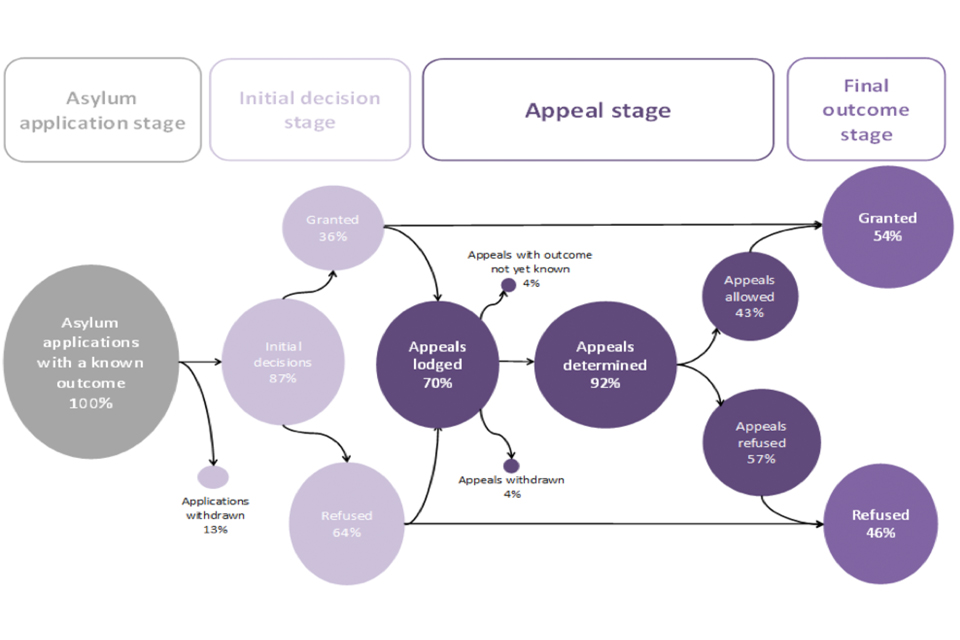
Source: Asylum tables – Outcome analysis of asylum applications
Notes:
- Appeals lodged are presented as a proportion of all initial decisions (except grants of asylum).
- Data include all asylum applications where the application raised date was between 2016 and 2018.
- Cases where the initial decision is unknown are not included in this analysis.
- Grant rates shown here relate to the outcomes of total applications made in each cohort year excluding withdrawals.
3.1 Latest outcomes for applications made in 2019
Of those who applied for asylum in the UK in 2019, 24,063 cases are currently awaiting an outcome. As more initial decisions are made, and more appeals completed, the number of grants and refusals for all years (but particularly more recent years) will increase, and this will be reflected in future statistics.
Figure 6: Final outcome of asylum applications, by type of outcome1,2
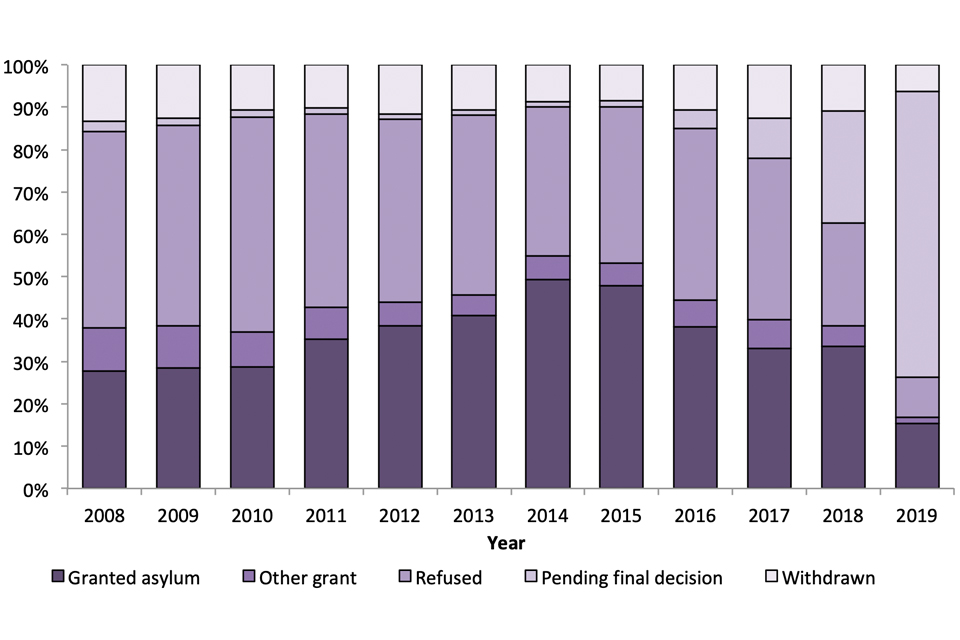
Source: Asylum tables – Outcome analysis of asylum applications
Notes:
- Data are based on date of application, and the outcomes are as at the point of data extraction in May 2020.
- The proportion of applications awaiting an outcome (either an initial decision or an appeal) will be lower in earlier years as more time has elapsed for the cases to be processed than those from more recent years.
The overall proportion of applications granted asylum or a form of leave at final outcome (where it has been reached), was estimated to be 27% in 2004; this proportion steadily increased to 59% for applications made in 2015. The estimated grant rate for 2019 is around 64%, however the proportion of applications awaiting an outcome (either an initial decision or an appeal) increases for more recent years as less time has elapsed for the cases to be completed, making any comment on the overall trend for these years provisional.
4. Support provided to asylum seekers
At the end of June 2020, 45,769 asylum seekers in the UK were in receipt of support under Section 95 of the Immigration and Asylum Act 1999, similar to the previous year.
Of these, 42,289 (92%) were in receipt of both accommodation and subsistence, and 3,480 (8%) in receipt of subsistence only. The majority (83%) were located in England, with smaller supported populations in Scotland (8%), Wales (7%) and Northern Ireland (2%).
An additional 5,357 individuals were in receipt of support under Section 4 of the Immigration and Asylum Act 1999, providing support where a claim has been rejected (up 38% from the previous year) and 5,444 individuals were in receipt of support under Section 98 (nearly 3.5 times higher than the same time in the previous year). The sharp increase is likely related to COVID-19, for further information follow the link detailing the use of temporary hotels to house asylum seekers during COVID-19. Section 98 support is provided to asylum seekers on a short-term basis while their application for section 95 support is considered.
As at the end of June 2020, 3,798 asylum seekers with an address registered in Glasgow City were in receipt of Section 95 support, the highest of all local authorities (equivalent to 6 asylum seekers per thousand residents).
In 2019, the latest data available, there were 20,009 applications for Section 95 support, an increase of 15% compared to the previous year. This increase comes at a time when asylum applications increased, by 21%, over the same period.
Figure 7: Asylum seekers supported under Section 95 per million population1,2, by local authority3 as at end of June 2020
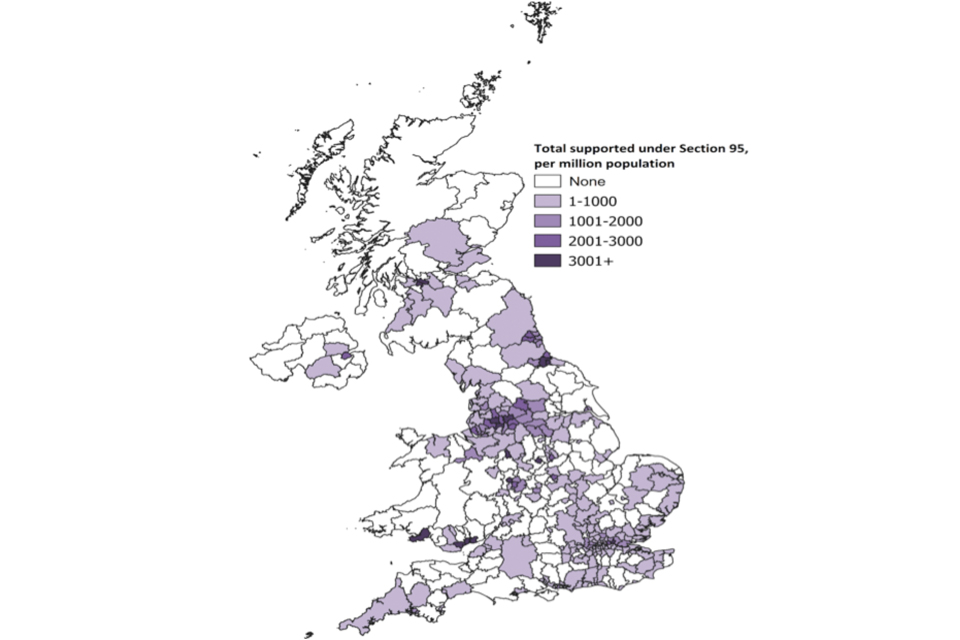
Source: Asylum tables – Section 95 support by local authority)
Notes:
- Includes main applicants and dependants.
- Local authority data are based on the registered address of the asylum seeker. This is not necessarily the location at which the individual regularly resides.
- Excludes those with an unknown local authority
5. Dublin Regulation
In 2019, the latest year available, there were 2,236 requests from other member states to transfer individuals into the UK under the Dublin Regulation. There were 714 transfers into the UK under the Dublin Regulation. The majority (496) of these transfers came from Greece.
Over the same period, there were 3,258 requests from the UK to transfer individuals out of the UK to return them to other member states. There were 263 transfers out of the UK under the Dublin Regulation. Of these transfers, 104 (40%) were transfers to Germany and 53 (20%) were transfers to France.
6. Section 67 of the Immigration Act 2016
Section 67 of the Immigration Act 2016, also known as the ‘Dubs’ amendment, committed the UK to bring 480 unaccompanied asylum seeking children (UASC) to the UK from Europe. All 480 UASC have now been transferred to the UK from the participating States of France, Greece, and Italy. Additional breakdowns on those who have transferred to the UK under the ‘Dubs’ scheme can be found inside the tables for transfers to the UK under Section 67 of the Immigration Act 2016. Further details about the scheme can be found in the ‘Dubs Factsheet’ on GOV.UK.
7. The impact of COVID-19
The Home Office published a separate report on 28 May 2020, which provided a statistical overview of COVID-19 impacts on the immigration system through into April 2020. However, there are further changes visible in the period to the end of June 2020.
In the second quarter of this year (April to June 2020), the number of people granted protection or other forms of leave was 68% lower than the same period in 2019, although there was a sharp increase in decisions being made in May and June 2020.
At the same time, asylum applications in the second quarter of 2020 fell by 37% compared with the same quarter in the previous year, although following a sharp fall in April there has been a recovery in May and June 2020.
8. About the statistics
This section provides information on those applying for and granted protection in the UK through both asylum and resettlement routes, as well as information on the numbers in receipt of asylum support.
The data are used to assess the trends in numbers of people seeking and being granted protection, the impact of policy changes, and to understand the demographics of those coming to the UK to claim protection. Data on resettlement and support, broken down by local authority, can help local authorities understand the demands on their services and resources to aid with planning.
8.1 Asylum, resettlement and protection
The total number of individuals granted protection includes grants related to an asylum application (grants of asylum or alternative forms of leave) and resettlement. Alternative forms of leave include humanitarian protection, discretionary leave, UASC leave, leave outside the rules, and grants under family and private life rules. Further details can be found in the user guide.
Data on asylum applications relate to the period in which the application was lodged, and initial decisions relate to the period in which the decision was made. Initial decisions may, therefore, relate to an application made in an earlier period, and thus the two are not directly comparable.
Data on initial decisions will not reflect the total number of people granted protection through asylum routes as some initial decisions may be overturned following appeal. Data on the number of appeals lodged, and their outcomes, are published in Asylum appeals lodged and determined – Asy_D06 and Asy_D07.
UASC data includes those treated as an unaccompanied minor for at least one day between the date of application and the date of initial decision. Some UASC applicants may subsequently be found to be an adult following conclusion of an age dispute. Data on age disputes are published in Asylum applications, initial decisions and resettlement – Asy_D01 and Asy_D02.
Eurostat asylum statistics can be used to compare asylum statistics with EU member states. The methodology used to compile Eurostat data differs from that used in this release. Further details can be found in the user guide.
The UK Community Sponsorship scheme was launched on 19 July 2016. The scheme allows community groups to support refugee families directly and aims to help them become self-sufficient and integrated members of the community. These figures are a subset of those published under the VPRS and VCRS and are not in addition to those resettled under these schemes. Further details can be found on the Community sponsorship scheme launched for refugees in the UK, GOV.UK page.
Family reunion visas are a subset of the ‘Family – other’ visa category, published in the visa tables. The vast majority of ‘Family – other’ visas related to family reunion visas. Data on Family reunion visas come from a different administrative system to other visa data so are not directly comparable. Further details can be found in the user guide.
8.2 Support provided to asylum seekers
Section 95 support is provided to destitute asylum seekers until their claim is finally determined, which may encompass either accommodation or subsistence, or both. ‘Invalid applications for support and support type not yet known’ are cases that have been deemed invalid or which have not yet been assessed.
Section 4 provides support for individuals whose claim has been refused and who have exhausted their appeal rights, but who are destitute and are temporarily unable to leave the UK.
Section 98 support provides accommodation for asylum seekers who would otherwise be destitute and who are either awaiting a decision on an application for Section 95 support or are supported under Section 95 and are awaiting transfer to their accommodation.
The data show the number of people in receipt of support on a given day, but do not show the length of time for which someone receives support or the amount of support they receive.
8.3 Dublin
Dublin data are published on an annual basis in February.
The Dublin Regulation is EU legislation that establishes the criteria and mechanisms for determining which single state is responsible for examining an application for international protection. The criteria for determining the Dublin state responsible for examining the asylum claim, along with further details on the Dublin Regulation, are set out in the user guide.
The data show the number of requests from EU member states to transfer an individual into the UK, and the number of individuals transferred into the UK under the Dublin Regulation. They also show the number of requests from the UK to EU member states to transfer an individual out of the UK, and the number of individuals transferred out of the UK.
Data on arrivals relate to the period in which the individual arrived in the UK, removals relate to the period in which the individual was removed from the UK, and requests for transfer in/out relate to the period in which the request was made.
Data on transfers out of the UK under the Dublin Regulation are a subset of the published returns data found in ‘How many people are detained or returned?’.
9. Data tables
Data referred to here can be found in the following tables:
We welcome your feedback
If you have any comments or suggestions for the development of this report, please provide feedback by emailing MigrationStatsEnquiries@homeoffice.gov.uk. Please include the words ‘PUBLICATION FEEDBACK’ in the subject of your email.
We’re always looking to improve the accessibility of our documents. If you find any problems or have any feedback relating to accessibility, please email us.
See section 7 of the ‘About this release’ section for more details.
